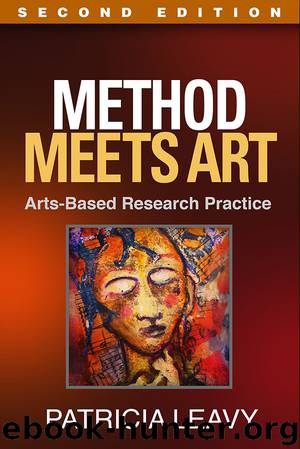Method Meets Art, Second Edition by Patricia Leavy

Author:Patricia Leavy [Patricia Leavy]
Language: eng
Format: epub
Publisher: The Guilford Press
DANCE AS A METHODOLOGICAL INNOVATION
Although dance and traditional research methods may seem disparate, they actually bear similarities particularly with respect to the process of choreography and the use of improvisation. Marybeth Cancienne and Celeste Snowber (2008) write: “[T]he choreographic process is one of sorting, sifting, editing, forming, making, and remaking; it’s essentially an act of discovery” (p. 198). Donald Blumenfeld-Jones (2008) explains that the choreography process involves researching a theme (through a literature review, observations, etc.), developing the theme, and then composing movements. The choreographer conceptualizes a dance and then watches the dancers to see what is actually possible. Blumenfeld-Jones writes: “[T]he choreographer analyzes the observed world, has a motional response, and interprets and rearranges the world through motion” (p. 177). Then he or she makes alterations upon watching the dancers. Clearly this is a similar process to ethnography, for instance, with motion replacing words. Improvisation, another element of dance and movement, can also mirror the experimentation required in much social research, as well as the revelatory moments that can follow.
Dance and movement methods allow us to pose questions, connect with emotions, understand theoretical concepts, raise consciousness, represent research findings (with the potential to reach broad audiences), and use the self as a place of discovery (Cancienne & Snowber, 2008). With regards to the latter, the influence of embodiment scholarship and phenomenology also coincide with the turn toward the self as a viable locus of inquiry. The rapid growth of autoethnography in the last two decades, reviewed in Chapter 2, illustrates the turn to self as a source of knowledge. This too is part of the context for dance-based methodological innovations. Dance-based practices can access bodily knowledge that is otherwise out of reach. Blumenfeld-Jones (2008) notes that the insights gained from dance are only available in that way. He explains that these insights emerge as a result of motion and “thinking through” motion (p. 175). He posits the dancer is thus both an “analytic instrument and analyst” (p. 176). In other words, dance itself can be employed as an act of inquiry (Blumenfeld-Jones, 2014). Another area where dance has considerable potential to contribute to our understanding is in regards to the public–private dialectic. Dance as a discipline merges the public and private, or inner and outer worlds, if we are to adopt the discourse of dance education, because the dancer’s body is always moving within an environment. Therefore, as these cutting-edge research practices are used and refined, it is likely that we will see more scholarship (outside of dance education) that explores this relationship.
As noted earlier, while still less utilized than other art forms, dance as a research tool has increased dramatically just in the last few years. In addition to the new studies that are reviewed in the following sections, there is also increased thesis work that uses movement and dance-based methods as a part of inquiry, indicating arts-based researchers are teaching these approaches to the next generation. There are many examples. For instance, Cheryl Annetta Kay (2012) uses
Download
This site does not store any files on its server. We only index and link to content provided by other sites. Please contact the content providers to delete copyright contents if any and email us, we'll remove relevant links or contents immediately.
On Writing A Memoir of the Craft by Stephen King(4891)
The Doodle Revolution by Sunni Brown(4713)
A Simplified Life by Emily Ley(4129)
Mummy Knew by Lisa James(3653)
Marijuana Grower's Handbook by Ed Rosenthal(3640)
Better Homes and Gardens New Cookbook by Better Homes & Gardens(3547)
Figure Drawing for Artists by Steve Huston(3409)
Paper Parties by Erin Hung(3397)
Draw Your Day by Samantha Dion Baker(3318)
The Genius of Japanese Carpentry by Azby Brown(3254)
Japanese Design by Patricia J. Graham(3136)
The Code Book by Simon Singh(3127)
Dangerous Girls by Haas Abigail(2994)
Lions and Lace by Meagan Mckinney(2941)
The Curated Closet by Anuschka Rees(2940)
How to Make Your Own Soap by Sally Hornsey(2865)
The Checklist Manifesto by Atul Gawande(2808)
The Wardrobe Wakeup by Lois Joy Johnson(2754)
Zero to Make by David Lang(2753)
